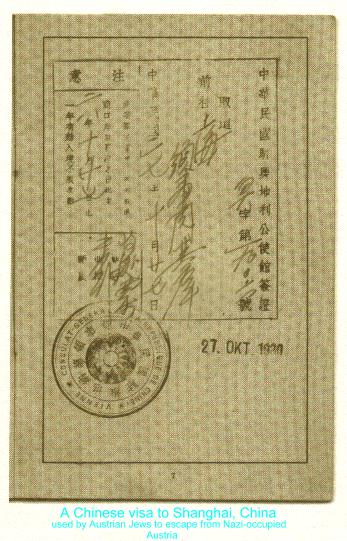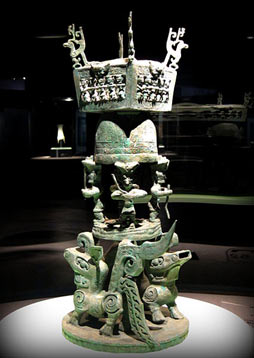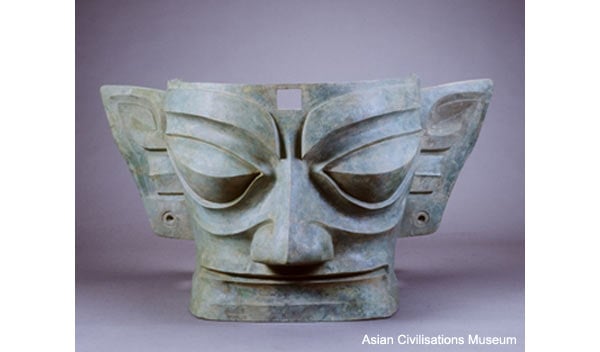日志
Thousands of years' Friendship between Israel and China
|
Thousands of years' Friendship between Israel and China
--- Probing the origin of the Friendship of Israel and China
Frank Dec. 26, 2014 in Waterloo, Ontario, Canada
[Highlights] The people of China has no tradition of anti-Semitism, so that Jews could live in China without fear of persecution -- and thus make a nice living.
Dec. 26, 2014, the article How did Chinese become America's favorite ethnic cuisine inspired me to think of that Israelis like to eat Chinese food have long historical roots, because of their ancestors have been living in China snce thousands of years ago.
I would like to discuss this issue with following topics:
1. Unearthed relics date back Jews in China since 3,000 to 5,000 years ago.
2. Written records of China date back Jews in China about 2,000 years ago
3. Czarist drive out Jews of Russia to build a happy paradise in Harbin China
4. A China Schindler helped tens of thousands of Jews to Shanghai China in WWII
5.Shanghai people saved Jews when Japanese blocked them to get foods
6. Chinese Schindler Ho Feng-Shan is widely appreciated
7. The civilization of China cultured humanitarian Dr Feng Shan Ho
1. Unearthed relics date back Jews in China since 3,000 to 5,000 years ago.
Mar. 28, 2014, the article The Mysterious Ancient Artifacts of Sanxingdui that have reported that: Amid the once-tranquil village of Sanxingdui, Sichuan province China, a discovery has rewritten the history of the civilisation of China. Two giant sacrificial pits were unearthed containing thousands of gold, bronze, jade, ivory and pottery artifacts that were so unusual and unlike anything ever found in China before, that archaeologists realised they had just opened the door to an ancient culture dating back between 3,000 and 5,000 years.
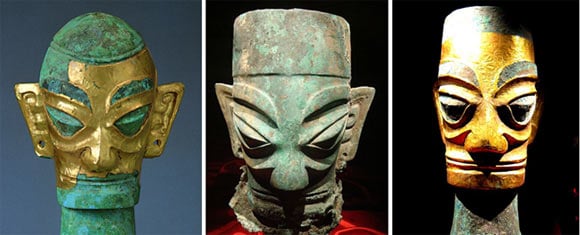
Dozens of bronze heads were found in the pits, some containing gold foil masks
, the article Sanxingdui — the legacy of ancient Jewish Culture said that: Combining the world cultural history and expert research, Sanxingdui civilization is based on the ancient Jewish immigration as the core of the Semitic Western regime, the Sanxingdui civilization is substantially more ancient Jewish culture.
2. Written records of China date back Jews in China about 2,000 years
The article Detailed History of Kaifeng Jews - The Sino-Judaic Institute said with that:
Jews had lived in China after 92 CE during the Han dynasty (206 BC – 220 AD). Israelite settlers and a synagogue are mentioned by name in a poem of Tang dynasty (618-907 AD) . There other records were confirming Jewish settlers in the 7th century.
But, the first time that Israelites referred to their own presence in China was in the Song Dynasty (960-1279). Beginning in 960 CE., China was ruled by the emperors of the Song Dynasty from their capital at Kaifeng, a bustling metropolis straddling the legendary Silk Road that linked their sprawling domain to its trading partners in the West. And, it was sometime during this period that a group of Israelites were invited for an audience with the emperor.
3. Czarist drived out Jews of Russia to build a happy paradise in Harbin China
The article A Brief History Of The Jews Of Harbin said with that: By the end of the 19th century, Jews in Czarist Russia were desperate to escape the country’s poverty, pogroms and institutionalized anti-Semitism. Visas to America did not grow on trees, and Jews had trouble obtaining permits for any kind of travel, even within Russia. However, in a little known footnote to history, the Czar who plagued and reviled his Jewish subjects also offered them an out.
The Russian government in 1895 had leased a land concession from China to build the Chinese Eastern Railway across Manchuria as an extension of the cross-country Trans-Siberian line. Once the tracks were laid, the Czar was so eager to establish Russia’s economic hold along the route that he offered Jews a chance to live without restrictions if they moved to Manchuria. They could chose between small communities in the Manchurian outback or the larger settlement of Harbin, where was originally a cluster of sleepy fishing villages to have become the railroad’s administrative hub and was developing into a thriving frontier town.
At the end of the 19th century, Jews arrived Harbin at a particularly fortunate moment in time. They enjoyed the “boom town” experience that accompanied frontier expansion, as well as the cultural development nurtured by the wealth of new entrepreneurs. For most members of the Harbin Jewish community, the sojourn in China meant the start of a new, prosperous and dynamic life.
Although desperation led many Jews to China, a large number new “Harbiners” also welcomed the opportunity to be pioneers in an uncharted land. Even better, was that local Chinese had no tradition of anti-Semitism, so that Jew could live in Harbin without fear of persecution -- and make a nice living, too.
The Harbin Jewish population reportedly topped 20,000 at its peak in the 1920s. There were two major synagogues, the Main or “Old” Synagogue and the New Synagogue. The Jewish community also established a library, a Talmud Torah, an elementary and a secondary school, a cemetery, a women’s charitable organization, a soup kitchen, a home for the aged and a Jewish hospital, which treated both Jews and non-Jews.
Jews were furriers, bankers, bakers, shopkeepers, restaurateurs, teachers and people of letters and the arts. They owned coal mines, lumber mills, breweries and candy factories. The Jewish-owned Hotel Moderne boasted a restaurant, a cinema, a billiard room, a bar and a barber shop. Because of its ornate, European-inspired architecture, Harbin became known as the “Oriental St. Petersburg” and the “Paris of the Orient”. Its rich cultural life led to the nickname “City of Music.”
4. A China Schindler helped tens of thousands of Jews to Shanghai China in WWII
In 1997, Ho Manli, the daughter of Dr. Ho Feng-Shan posted an obituary in a newspaper, with one line about her father’s work in Vienna. This was read by Dr. Eric Saul, an American professor of Jewish history and a Holocaust historian, who then embarked on the painstaking work of collecting evidence from those (and their descendants) who had received visas from Ho. Only after that, the history and hided deeds of Ho Feng-Shan who helped Jews at the risk of their own lives to be recognized and deeply moved the Israelis.
In WWII, the diplomat of China in Vienna - Ho Feng-Shan who hardly rescues Jews by issuing them visas to Shanghai China with risking own life when all of other countries refused to do so in fear of Germanfascism. http://www.vcn.bc.ca/alpha/DrHo.htm
In 1938, following the Anschluss that Austrian voted in favour of annexation of Austria into Nazi Germany, the Austrian anti-Semitism erupted in full force, all foreign embassies and legations in Austria were closed.
The plight of Austrian Jews was further exacerbated by the July 13 resolution of the Evian Conference, which made it evident that none of the 32 participating states were willing to open its doors to Jewish refugees.
Vienna became the centre for emigration of Austrian Jews. All foreign consulates in the city were besieged by desperate Jews day after day, but most did not offer help. The British consulate posted a sign saying no visas would be issued; the French would not accept any visa applications. The Swiss demanded that passports be stamped with the red "J" in order to bar them from crossing the border.
In May 1938, Dr. Ho Feng-Shan was appointed as Chinese Consul General in Vienna, and he was a man of conscience to have noticed that Jews of Austria were increasingly in danger with urgently need to help.
The 'means' of the Consul General Ho used to help Jewish refugees was to issue them visas to Shanghai, China by practice of a "liberal" visa policy, authorising the issuing of visas to any and all who asked. Having been turned down by many consulates, Jews soon discovered that they could get visas at the Chinese Consulate. Soon, lines of desperate refugees formed at the Chinese Consulate seeking the lifesaving visas with Word spreaded.
In the next 2 years, the compassionate Chinese Consul General in Vienna issued visas to any and all Jews who requested them. After exhausting their supply of official forms, they even used ordinary paper stamped with the consular seal, even in the case of that applicant can not apply in person, as long as any people can provide the name and related information, he will issue visas. A record said that one applicant got 12 visas and there 11 were for others who could not apply in person.
With such a simple way, Dr. Ho saved thousands [estimated 18,000] of Jews in 1938 and 1939.
Why was Dr. Ho Feng-Shan willing to help the Jews of Austria with risking own life when most others would not? His reason was simple: "I thought it only natural to feel compassion and to want to help. From the standpoint of humanity, that is the way it should be."
April 23, 2012, an Mandarin article China Schindler - Ho Fengshan said with that, from morning to night, in the front of the Consulate General of China long queued every day, there many helpless Jews got life-visa to go to Shanghai China, which caused dissatisfaction of Nazi authorities, they confiscated the house of consulate of China by the name of the property of the Jews. Ho quickly moved the consulate to a small house on his own money to insist the issuance of visas until May 1940 that government of China ordered him to return to China.
5. Shanghai people saved Jews when Japanese blocked them to get foods
The History of the Jews in China - Wikipedia introduced with that: Late in the WWII, Nazi representatives pressured the Japanese army to devise a plan to exterminate Shanghai's Jewish population, and this pressure eventually became known to the Jewish community's leadership. However, the Japanese had no intention of further provoking the anger of the Allies after their already notorious invasion of China and a number of other Asian nations, and thus delayed the German request until the War ended.
However, the Japanese took a more brutal means to have completely isolated the Israeli community from the outside world by steel gate with the hope of their own starving to die in lacking food. But, theynever thought of that, there always Chinese people were throwing foods to Jews over the wall when the Japanese can not see. So that Israeli could survive, which was last about one year long.
6. Chinese Schindler Ho Feng-Shan was widely appreciated
May 23, 2014, the article The Battles of He Fengshan said that:"In the Yad Vashem Museum of the Holocaust in Israel, a memorial plaque to He Fengshan stands quietly bathed in the light of Jerusalem, prominently engraved with the words, "The Chinese should never be forgotten." He Fengshan, born in 1909 in Yiyang, Hunan Province was a diplomat with the Republic of China. He became known as China's Oskar Schindler for saving countless lives by issuing thousands of visas to Jews in Nasi-occupied Austria. In 2001, he was awarded "Righteous Among Nations" by the Israeli government."
January 20, 2012, the article 'Chinese Schindler' to be honoured by MPs reported with that: "TORONTO — Three Toronto MPs will come together Thursday night to honour a man some refer to as the Chinese Oskar Schindler."
"The late Feng Shan Ho, a Chinese diplomat who helped thousands of Jews escape Nazi-occupied Austria by granting them immigration visas from 1938 to 1940, will be honoured by York Centre MP Mark Adler, Willowdale MP Chungsen Leung and Etobicoke-Centre MP Ted Opitz at the Hillcrest Library on Jan. 26 at 6:30 p.m"
"As many as 18,000 Jews reached Shanghai, and thousands more used their visas to reach other destinations, including Palestine, the Philippines and Cuba."
"Goldstaub, a 90-year-old Willowdale resident who was issued 20 visas for himself and his family members by Ho in 1938, plans to attend the event."
"In November, Goldstaub told the National Post that he owes his life to Ho." “If I never knocked on that door in Vienna, I would have been in a concentration camp,” he said. “And I would have died, I am almost sure of that. Our whole family would have died. We needed Feng Shan Ho. He saved us. It was a miracle.”
7. The civilization of China cultured humanitarian Dr Feng Shan Ho
Sep. 26, 2007, Dr Feng Shan Ho's daughter, Manli Ho who published article Remembering my father, Dr Feng Shan Ho on China Daily to have revealed the the humanity-root of Dr Feng Shan Ho.
During my 10-year pursuit of a history that has been buried for more than half a century, I was often asked why a Chinese diplomat would save Jews in Austria when others would not. My response has been: "If you knew my father, you wouldn't have to ask." That is usually followed by: "But weren't you surprised to discover this facet of your father?" No, I was not surprised because what my father did was completely in character.
My father's greatest legacy was to be who he was. He was a scholar and a gentleman, a product of his culture and of the times in which he lived, the likes of which we will never see again. But more importantly, he was a person who was never false, whose honor and integrity, whose strength of will, whose faith and optimism always shone through - and that was part of his charisma. He was loved and respected not just for what he was, but for who he was as a human being.
My father always felt that he had received a full measure of gifts. He was brilliant, fearless, charming and dynamic. He was also incorruptible, straightforward and conscientious. He possessed a hot temper - which I always attributed to his love for the hot peppers of Hunan. Among his most admirable traits was his capacity for love and for compassion. Most importantly, my father believed that these gifts were not bestowed upon him solely for his personal benefit, but for that of his fellow men.
Although he spent most of his adult years abroad, my father's love of his native land was fierce and unwavering. He taught my brother and me about our precious Chinese heritage and to take pride in being Chinese. He named us after two principles from the Analects of Confucius: , or Virtue, for my brother, and , or Propriety of Conduct, for me.
My father also came from a generation of Chinese who felt that China had been humiliated and persecuted by 100 years of foreign imperialism. His generation was determined not to allow that humiliation to continue. In that sense, my father was very sensitive to persecution and to the bullying of any peoples. His reason for helping Jewish refugees was simply this. He said: "I thought it only natural to feel compassion and to want to help. From the standpoint of humanity, that is the way it should be."
I believe this also answers the second question I am most often asked: "Why did he not talk about his deeds?" If helping those in distress was natural to a human being, why would it warrant particular praise or mention?
The ancient Chinese said: ""- "A good deed performed for others to see is not truly a good deed."
It has been an honor for me to be the daughter of Feng Shan Ho. I had the privilege of taking daily care of my father during the last years of his life, as he did for me during the first years of mine. Thanks to the people of his beloved Yiyang, I have now brought him home to rest in eternity. We have reached completion.
Recommended Video and Articles:
Video: China saved us - Jewish memories of Shanghai Jews refugees camp in World War II.
https://www.youtube.com/watch?v=ZniwPWyGqNM
Ho Feng-Shan who issues visas for Jewish refugees to China in World War II
Feng-Shan HO and the Rescue Of Austrian Jews
Shanghai Jewish Refugees Museum "Dr. Feng Shan Ho & Jewish Refugees–From Vienna to Shanghai"
Shanghai Jewish Refugees Museum - Wikipedia
Shanghai Ghetto - Wikipedia, the free encyclopedia
History of the Jews in China - Wikipedia
A Brief History Of The Jews Of Harbin China
The Mysterious Ancient Artifacts of Sanxingdui that have
Amid the once-tranquil village of Sanxingdui, in a quiet part of Sichuan province in China, a remarkable discovery took place which immediately attracted international attention and has since rewritten the history of Chinese civilisation. Two giant sacrificial pits were unearthed containing thousands of gold, bronze, jade, ivory and pottery artifacts that were so unusual and unlike anything ever found in China before, that archaeologists realised they had just opened the door to an ancient culture dating back between 3,000 and 5,000 years.
In the spring of 1929, a farmer was digging a well when he discovered a large stash of jade relics. This was the first clue that eventually led to the discovery of a mysterious ancient kingdom. Generations of Chinese archaeologists searched the area without success until 1986, when workers accidentally found the pits containing thousands of artifacts that had been broken, burned, and then carefully buried.
The discovery of the artifacts opened up a world of intrigue. The objects found in the sacrificial pits included animal-faced sculptures and masks with dragon ears, open mouths and grinning teeth; human-like heads with gold foil masks; decorative animals including dragons, snakes, and birds; a giant wand, a sacrificial altar, a 4-metre tall bronze tree; axes, tablets, rings, knives, and hundreds of other unique items. Among the collection was also the world’s largest and best preserved bronze upright human figure, measuring 2.62 metres (8 feet).
A sacrificial altar with several four-legged animals at the base to support a few bronze figures closely resembling the large face masks, each holding in outstretched hands a ceremonial offering of some sort. Photo source: Wikipedia
However, by far the most striking findings were dozens of large bronze masks and heads represented with angular human features, exaggerated almond-shaped eyes, straight noses, square faces, and huge ears, features which don’t reflect those of Asian people.
The artifacts were radiocarbon dated to the 12th-11th centuries BC. They had been created using remarkably advanced bronze casting technology, which was acquired by adding lead to a combination of copper and tin, creating a stronger substance that could create substantially larger and heavier objects, such as the life-size human statue and the 4-metre tall tree.

Dozens of bronze heads were found in the pits, some containing gold foil masks
Some of the masks were enormous in size – one measures an incredible 1.32 metres in width and 0.72 metres in height, the largest bronze mask ever found. The three largest masks have the most supernatural features of all the Sanxingdui artifacts, with animal-like ears, monstrously protruding pupils, or an additional ornate trunk.
Researchers were astonished to find an artistic style that was completely unknown in the history of Chinese art, whose baseline had been the history and artifacts of the Yellow River civilisation(s).
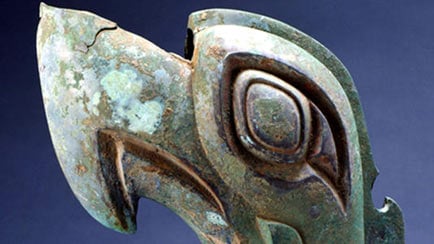
A bird or dragon-like bronze head. Photo source.
The spectacular discovery at Sanxingdui in 1986 turned Sichuan into a focal point in the study of ancient China. The ancient artifacts found in the two pits date to the time of the Shang dynasty, in the late second millennium BC, when the primary civilised society was flourishing in the Yellow River valley, in north China, thousands of miles from Sichuan. No similar find has been made anywhere else, and there are no inscriptions at the Sanxingdui site to shed light on its culture, which was apparently a distinctive Bronze Age civilisation, unrecorded in historical texts and previously unknown. The discovery contributed to a fundamental shift from the traditional understanding of a single centre of civilisation in north China to the recognition of the existence of multiple regional traditions, of which Sichuan was clearly one of the most distinct.
The culture that produced these artifacts is now known as the Sanxingdui Culture, and archaeologists are identifying it with the ancient kingdom of Shu, linking the artifacts found at the site to its early legendary kings. References to a Shu kingdom that can be reliably dated to such an early period in Chinese historical records are scant (it is mentioned in Shiji and Shujing as an ally of the Zhou who defeated the Shang), but accounts of the legendary kings of Shu may be found in local annals.
According to the Chronicles of Huayang compiled in the Jin Dynasty (265–420 AD), the Shu kingdom was founded by Cancong. Cancong was described as having protruding eyes, a feature that is found in the figures of Sanxingdui. Other rulers mentioned in Chronicles of Huayang include Boguan, Yufu, and Duyu. Many of the objects are fish and bird-shaped, and these have been suggested to be totems of Boguan and Yufu (the name Yufu actually means fish cormorant).
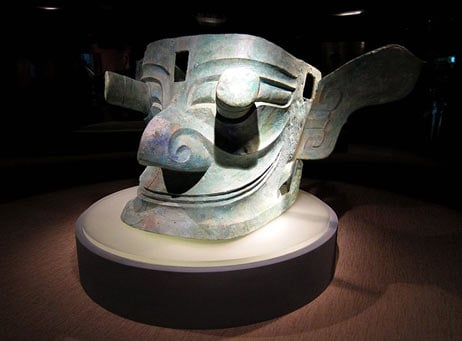
A large bronze head with protruding eyes believed to depict those of Cancong, the semi-legendary first king of Shu. Photo source.
A metropolis of its time, covering about three square kilometres, Sanxingdui had highly developed agriculture, including winemaking ability, ceramic technology and sacrificial tools and mining was commonplace. According to archaeological findings, the settlement at Sanxingdui was abandoned suddenly around 1,000 BC. For reasons that are still unknown, the prime of Sanxingdui Culture came to an abrupt end.
The sacrificial pits are believed to have been sites for the ancient Shu people to offer sacrifice to Heaven, Earth, mountains, rivers, and other natural gods. The human-like figures, bronze animal-faced masks with protruding eyes and flat bronze animal-faced masks may be natural gods worshiped by the Shu people.
"Judging from the numerous bronze human images and funerary objects, the ancient Sanxingdui kingdom had unified and ruled the people through primordial religion. They worshiped nature, totems and their ancestors. The ancient Shu kingdom probably often held grand sacrificial activities to attract tribes with different religious beliefs to come from far and near to worship," said Ao Tianzhao from the Sanxingdui Museum, who has been studying the Sanxingdui culture for half a century. He believes the large number of bronze artfacts at Sanxingdui indicates that this site used to be a mecca for pilgrims.
Since the discovery, these artifacts have received a great amount of international interest and attention. They have been exhibited at world renowned museums such as The British Museum, Taipei’s National Palace Museum, National Gallery of Art (Washington), Guggenheim Museum (New York), Asian Art Museum (San Francisco), Art Gallery of New South Wales (Sydney) and Lausanne Olympic Museum (Switzerland). A selection of the artifacts are now making their way to the Bowers Museum in Santa Ana, California, where the exhibition, ‘China’s Lost Civilization: the Mystery of Sanxingdui’, will be featured from 19thOctober 2014 to 15th March, 2015.
The discovery of Sanxingdui shocked the world, but the history of the artifacts remains a mystery. Only the contents of two solitary pits reflect the immemorial and brilliant civilisation of the Shu – no other artifacts like them have ever been found since. There are no historical records, and no ancient texts that speak of them, leaving experts asking what the purpose of the objects was, where the culture came from, and where they went after burying their most precious treasures. The Sanxingdui civilisation is a unique page in China’s long history and for now it remains an enigma.
Strange masks with projecting pupils and elephant-like ears, elephant tusks, trees and birds in bronze, gold ornaments and many types of jade carving, represent an imagined spiritual universe, quite unlike anything discovered elsewhere. Indeed, the culture is so strange, so unprecedented, that we cannot begin to describe the society that produced these objects...
Times Higher Education, December 1996
Featured image: A bronze mask of Sanxingdui. Photo source. By April Holloway
References
Historical Wonders of Sanxingdui – China.org.cn
The Sanxingdui Ruins - CriEnglish.Com
Sanxingdui Ruins Prove Diversity of Chinese Civilization – People’s Daily
Mystery Men: Finds from China's Lost Age – Asian Civilizations Museum
New Digging to Probe Mystery of Ancient Sanxingdui Ruins – People’s Daily
How did Chinese become America's favorite ethnic cuisine
BY MARLA JO FISHER / STAFF WRITER Dec. 24, 2014 Updated: 8:39 p.m.
http://www.ocregister.com/articles/chinese-646329-chen-food.html

Why do so many Jews eat Chinese on Christmas? And why is Chinese food overwhelmingly the most popular ethnic cuisine in America?
Yong Chen, 54, a history professor at UC Irvine, answers that question and many others in his new book, “Chop Suey, USA: The Story of Chinese Food In America,” published this fall.
When Chen arrived in the U.S. from China to attend graduate school in 1985, he was stunned to discover Chinese restaurants everywhere he turned. It had never occurred to him that so many Americans would be eating Chinese food.
And what they were eating amazed him – dishes that in China were obscure and unimportant.
Americans weren’t embracing delicacies such as shark fins or bird’s nests. They were eating noodles, as in chow mein and chop suey, found on the menu of every American Chinese restaurant.
As Chen finished graduate school, his interest in ethnic foods continued to grow. He taught classes on the subject and curated an exhibit at the Museum of Chinese in America in New York City.
And, he wondered, why were there some 30,000 to 40,000 Chinese restaurants all over America?
Researching the book, for him, became “a process of historical discovery,” Chen said. “It was surprise after surprise.”
How had Chinese become the most popular ethnic food in America, considering that, when the Chinese started arriving here more than a century ago, their cooking was despised as “smelly” and prepared with questionable ingredients?
The Saturday Evening Post “reported” in 1860, that the “Chinese ate dogs and cats,” adding that “the rat is also an animal which occupies a large place in the food of the Chinese.” That fiction continued throughout the years, Chen said – a myth he’d never heard before he left China.
As Chinese immigrant laborers moved into new roles as domestic servants, some began to be prized as excellent cooks. But not for their own cuisine. “Even when Chinese were hired to cook for Americans, they were cooking American food, not their own,” Chen said.
So how did Chinese food become so popular?
Chen found that the rise of Chinese restaurants, around the turn of the 20th century, came despite rampant discrimination against people of Chinese origin.
At the end of the 19th century, affluent Americans began to visit Chinatowns in large cities for exotic entertainment. Those without money looked on enviously, and wanted their own experience of China.
Among the Chinese, there was a widespread belief that their cuisine became popular because it was the most delicious in the world. And some diners did compare Chinese cooking to French – the highest praise in an era when French was considered the epitome of fine cuisine.
But Chen’s book describes economic and social factors that were as important as taste in driving the new American interest in “eating Chinese.”
“The primary reason was not culinary,” said Chen, a dedicated foodie. “That’s not to say that Chinese food doesn’t have gastronomical merit. It is the oldest cuisine and very complex. It was an exotic taste and very different from European food.”
As wages rose in the early 20th century, Chen found, the middle class wanted the same perks as the wealthy – including the privilege of eating food cooked by others.
In those days, there was no “take-out” culture, no McDonald’s, no Burger King. And home cooking on old-fashioned stoves was an exhausting experience. You were either rich, in which case you had a cook or dined in elegant hotspots, or you weren’t, and had no option but to eat at home.
Chinese immigrants, barred from most jobs by virulent discrimination, found work in the cities primarily by working as servants, in laundries, or by opening restaurants that offered delivery and take-out food.
Americans began embracing their neighborhood Chinese restaurants as special places where they could be treated to a meal they didn’t have to cook. And began appreciating the flavors of the exotic cuisine.
“They were among the first to deliver food into the hands of consumers,” Chen said. “Chinese food became known for delivery. They delivered food right to your doorstep.”
Even today, as diners have embraced chains, Chen said most of the Chinese restaurants remain independently owned and operated small businesses. (His 2007 survey found 30,000 in 62 cities across the U.S.) However, neither the restaurant owners nor the customers in these modest surroundings had the money for any of the upscale, fancy cuisine enjoyed by Chinese aristocrats.
Instead, what they served and ate were inexpensive dishes based around noodles and rice: chow mein, chop suey, fried rice. Sound familiar?
So why were Jews eating Chinese? Especially on Christmas?
Just as Chinese were barred from working due to racial discrimination, in the past, Jews were unwelcome in many upscale restaurants due to rampant anti-Semitism. Chinese restaurants never made them feel unwelcome, though.
And, on Christmas – a holiday that Jews typically had off work but didn’t celebrate – there were few places for them to go out and eat.
Most Chinese restaurants were open, however, on Christmas and other Christian holidays.
So generations of Jewish families made a tradition of going to “eat Chinese” on Christmas.
“It’s a longstanding tradition that goes all the way back to the late 19th century and has continued to the present,” Chen said. “Not just on Christmas, but on the weekends as well. In the eyes of Jewish immigrants, eating Chinese was part of becoming American and joining the middle class.”
You can also add one other family to the list – the Bumpus clan in the movie “A Christmas Story,” which went out to eat a Chinese dinner after a pack of dogs destroyed their Christmas turkey.
But we aren’t still eating all noodles and rice. These dishes remain at the heart of American Chinese cuisine. But, as the world grew smaller, inevitably, more and varied types of Chinese cuisine came to America. Nowadays, Americans are as likely to order kung pao or Mongolian dishes as they are chow mein.
Chen pointed to a 1965 immigration law allowing more Chinese to come to the U.S., bringing their own regional cuisines. These quickly seized the popular imagination, leading to an appreciation that Chinese food was more than just Cantonese, for example.
But what about chop suey?
“Chop suey was for many years the most famous and popular of all Chinese dishes in the U.S.,” Chen wrote in his book.
There was even a song, “Chop Suey,” in the popular movie “Flower Drum Song,” about Chinese immigrants in San Francisco, about the culture clash between American and Chinese values.
For decades, foodies have argued about whether chop suey was actually Chinese at all, or an American concoction. Chen comes down firmly on the Chinese side, arguing that the blend of stir-fried meat and vegetables has many different components in different locations, but is similar to the food his mother cooked in her kitchen.
Nowadays, though, chop suey is an endangered species, and diners heading out today for their Chinese meal may not even find it on the menu.
Chen recently surveyed 19 restaurants in non-Chinese populated parts of Orange County, such as Huntington Beach and Tustin, and found only three of them even had chop suey on their menus.
“Around here, chop suey is basically over,” Chen said. “Though in some major cities like Detroit, Chicago or St. Louis, you can still find chop suey places. There’s a chop suey place in Ferguson.”
Contact the writer: mfisher@ocregister.com or 714-796-7994
About the author: Yong Chen, raised by his food-loving mother in China, is a professor of history at UC Irvine and served as the university’s associate dean of graduate studies from 1999 to 2004. His numerous publications include Chinese San Francisco, 1850–1943: A Trans-Pacific Community.
About the University of California, Irvine: Founded in 1965, UCI is the youngest member of the prestigious Association of American Universities. The campus has produced three Nobel laureates and is known for its academic achievement, premier research, innovation and anteater mascot. Led by Chancellor Howard Gillman, UCI has more than 28,000 students and offers 192 degree programs. Located in one of the world’s safest and most economically vibrant communities, it’s Orange County’s second-largest employer, contributing $4.8 billion annually to the local economy.
Media access: Radio programs/stations may, for a fee, use an on-campus ISDN line to interview UC Irvine faculty and experts, subject to availability and university approval. For more UC Irvine news, visitnews.uci.edu. Additional resources for journalists may be found at communications.uci.edu/for-journalists.
二战时中国外交官发放"生命签证" 两万犹太人避难上海滩
丁翔华 2011年05月30日14:25 来源:《文汇读书周报》
第二次世界大战期间,德国法西斯大肆迫害犹太人,慑于纳粹的淫威,欧洲多国拒收犹太难民。而在此刻,中国上海向犹太难民们敞开了大门,中国驻维也纳总领事何凤山给许多犹太难民发放了生命签证,2万多犹太难民和居住在虹口的10万中国人在狭小的空间里,度过了二战艰难的岁月,留下了难忘的真情。

上海虹口犹太难民纪念碑
第二次世界大战期间,德国法西斯大肆迫害犹太人,慑于纳粹的淫威,欧洲多国拒收犹太难民。而在此刻,中国上海向犹太难民们敞开了大门,中国驻维也纳总领事何凤山给许多犹太难民发放了生命签证,帮助他们逃离死亡魔窟。上海虹口区的摩西会堂刻录了犹太难民在虹口生活的印记,2万多犹太难民和居住在虹口的10万中国人在狭小的空间里,度过了二战艰难的岁月,留下了难忘的真情。
中国的“辛德勒”何凤山
第二次世界大战期间,有一位叫辛德勒的德国实业家,救助了大批面临屠杀命运的犹太人,他的故事被拍成电影《辛德勒的名单》后,举世震撼。而在中国,也有这样一位“辛德勒”,但他的义举无人知晓,湮没了60余年,直到上世纪末,才在上海犹太研究中心和美国“救命签证”等组织的努力下,被发掘出来。
1995年5月,上海犹太研究中心主任潘光到奥地利萨尔茨堡参加“奥地利犹太难民在上海避难五十周年”纪念活动。活动结束后,很多犹太难民和潘光聊天时提到,当年是拿了中国驻奥地利总领事的签证才逃到上海的,只是记不清总领事叫什么名字了。当时外国人要进入中国上海是不需要签证的,但是要逃离纳粹统治区却必须要出示签证,是哪位中国外交官在为犹太难民签发“生命签证”的呢?
1998年,通过上海犹太研究中心提供的线索,由美国“救命签证”组织尽力查找,最后确认,这位中国的总领事叫何凤山。
何凤山是湖南益阳人,生于1901年,1932年在慕尼黑大学获得博士学位。1935年参加外交工作,1937年他被派往中国驻奥地利大使馆工作,1940年5月离开维也纳,回国到重庆参加对日作战,后在美国加州定居。在找到何凤山女儿的时候,何凤山先生已于一年前的1997年9月28日去世,享年96岁。但他留下的一本回忆录,帮我们再现了当年的救助场景———一个犹太青年,跑了40多个领馆,没有一个领馆肯给他签证,最后他找到了何凤山。何凤山说我给你发签证,他说我要11张。发签证必须是要本人亲自来的,但是何凤山给他发了,11张。犹太青年拿了11张签证救出了他10个亲戚朋友,在集中营里,就凭着签证,一张一条命。
何凤山全力救助犹太人的消息被迅速传开后,让许多徒劳奔波于若干个国家大使馆的犹太人绝处逢生,于是中国驻维也纳总领事馆的门前很快排起了长队。何凤山的善举曾遭到国内同行的猜忌,但他光明磊落不为所动。法西斯当局则以中国领事馆租用犹太人房子为由,硬将房子没收了。何凤山便自己出钱租用了一处小房子,继续给犹太人核发“救命签证”。何凤山到底向多少犹太人发放了签证,至今都没有一个准确的数字。但从1938年6月到10月,仅以找到的签证号码推算,他就发放了1900多份,而1938年纳粹11月大屠杀后,何凤山为犹太人发放的签证就更多了。可他从来不提这件事情,连他女儿也知道的很少,所以才会几十年来不为外人所知晓。
2001年1月23日,以色列政府在耶路撒冷的犹太人大屠杀纪念馆举行隆重仪式,授予何凤山“国际义人”荣誉称号。何凤山的儿子和女儿代父亲接受了荣誉证书和证章,被何凤山救助的犹太人及后裔出席了仪式。德国前总理施罗德在何凤山的纪念碑前说:“在他的面前,我们看到了人性的光辉,从而感到了我们自身的渺小。”
虹口生活印记
1937年到1939年8月,是犹太难民涌入上海的高峰期,他们被安排居住在上海虹口区提篮桥一带的舟山路、霍山路、长阳路。长阳路上的摩西会堂,曾是犹太难民们经常聚会和举行宗教仪式的场所,1994年起,这里成为了上海犹太难民纪念馆。无数犹太难民和他们的后裔来到这里追寻历史的记忆。有的在摩西会堂墙上看到了自己当年在上海的通行证,有的遇见了中国的老邻居。最让他们感慨的是还保留完好的原居住地。他们说见到这一切让人触景生情,并希望能作为历史遗产被继续保存下去,“因为它们是我生命的一部分”。1994年,上海虹口区霍山公园犹太难民纪念碑落成。在坚硬的石碑上分别用中文和希伯来文刻着这样一段文字:“第二次世界大战期间,数万犹太人为逃避法西斯的迫害来到上海,日本侵华当局以犹太难民无国籍为由,设立隔离区,对他们的行动加以限制。”
原本逃亡到上海的犹太难民生活已逐渐走上轨道,但是随着1941年太平洋战争的爆发,日本占领者将上海推入了更为黑暗的深渊。1943年2月,日本把大部分逃亡到上海的犹太人赶进虹口犹太难民隔离区,并用发放通行证的方式来限制犹太人的人生自由。如果拿不到通行证,就没有机会上学、打工、谋生。于是拥挤到隔离区里的犹太人,必须为生存挣扎,不可避免地挤占了中国人的生活空间。而成千上万善良的中国人尽管自己也陷于水深火热之中,但是他们仍然对逃亡到上海来的犹太难民提供各种方式的援助。
患难见真情
据当年的犹太难民回忆,那时中国人用低价把房子租给他们,他们成了邻居,这种亲切的感觉,如同回到了家乡。
一位叫马丁的犹太人用摄像机录下了他小时候曾在上海虹口住过的院落。他说:“我妈妈那时已不在了,我和父亲一起过,因而常会挨饿且没人照看。而丁先生、丁太太总是尽力帮助我,给我们些米啊什么的,这些我永远不会忘记。”
在患难之中,中国居民与犹太难民朝夕相处,成为了朋友和亲人。对于那些犹太难民来说,后来的每一次回访重聚,甚至在马路上偶然遇到的老街坊,都令人动情。
2万多犹太难民和原先就居住在虹口的10万中国人挤在一块不到1平方英里的狭小空间里,共同度过了二次大战中最后一段艰难的岁月。不过奇迹也随之出现了:不管你是来自德国、奥地利,还是来自波兰、匈牙利等东欧国家,也不管你是犹太人还是中国人,信仰犹太教还是崇尚儒家伦理学说,大家都在艰难中平等相待、和睦相处。当希特勒把600万犹太人抓进集中营进行骇人听闻的屠杀时,近3万犹太难民却在上海存活下来,并开创了新的生活。
“水晶之夜”事件发生后,纳粹大肆逮捕犹太人,许多犹太人逃到了上海,并融入了上海。一位叫布鲁赫的聋哑青年画家与中国聋哑姑娘结了婚。世界著名小提琴手维滕贝格靠教中国学生小提琴和钢琴度日,他教过的许多学生后来都成了中国音乐界的名人。一对德国犹太音乐家兄弟,在上海组织乐队制作流行歌曲唱片,让中国的流行歌曲走向了世界。
1938年11月9日晚,德国法西斯捣毁了大批犹太人的商店、会堂和住所,一个新的更大规模的反犹太人浪潮开始了。这个被称为“水晶之夜”的事件发生以后,纳粹大肆逮捕犹太人,一个叫大卫·布鲁赫的青年画家被关进了德国达豪集中营。大卫是个聋哑人,他被释放后来到了慕尼黑,在那里他收到了表哥从美国发来的电报,上面只有3个字——“去上海”。
犹太画家结缘上海姑娘
大卫·布鲁赫听从了美国表哥的指点,很快乘海轮逃亡到了上海。“那是一段奇妙的经历,”大卫说,“在上海我很幸运地结识了一个叫‘陈’的朋友,会吹笛子、弹琵琶,还会演戏,他经常带我到中国家庭做客,那些中国人对我都很好,还经常留我吃饭,我到现在还记得他们。”
大卫的话只有他儿子能懂。大卫儿子说,在上海时,父亲认识了两个聋哑人,并成了朋友。由于中国和德国的手语不同,他们交流起来很困难,但这并不妨碍他们成为好朋友。这两个人带父亲去参加聋哑人聚会,在那里认识了我母亲。他们是1941年认识,1946年结婚的。
虽然欧洲人的习俗和中国的不同,彼此很难沟通,但大卫·布鲁赫与他的中国夫人做到了互相理解和体谅。他说在她简单的手势上我体会得出她对生活充满了深刻的理解和热爱,我们之间存在着一种常人想象不到的默契。
就这样,这位中国聋哑姑娘把命运同一个犹太难民画家紧紧连在一起,一直到她在美国离开人世。
在上海的时候大卫结交了一群中国的艺术家朋友,他们教他练毛笔字,其中一位中国朋友还为他起了个中国名字叫“白绿黑”。几十年过去了,他说这段生活仍然留在他的记忆里,挥之不去。大卫·布鲁赫是一个凭感觉来创作的画家,在他的画里倾注了他许多的感情。黄包车就是他最爱画的主题,因为他同情拉黄包车的人,觉得他们很辛苦。1997年他出的画册里就有60幅是画黄包车的。其中有黄包车为人家搬场的场景,有卡车抛锚由6辆黄包车一起拖车的场景。这些画面,连许多老上海都没有看到过。大卫·布鲁赫的画是将上海情愫融入了自己的文化血脉中的艺术再现。
著名演奏家情系上海
在上海避难期间,犹太难民中的编辑记者们办起了德文报刊,艺术家们在露天音乐会演奏肖邦和德沃夏克,戏剧、舞蹈、漫画、报纸,表达着他们不可湮没的人生希望。在这同时,许多犹太难民中杰出的音乐家,也把自己的才华传授给了中国的同行。
上世纪30年代,世界一流水平的德国柏林歌剧院第一小提琴手维滕贝格为了躲避纳粹的迫害,早在1939年2月,就随同近3万犹太难民逃亡到上海。当时德国纳粹规定,犹太人离开德国只准携带10马克现金。维滕贝格到达上海时囊空如洗,只能靠教中国学生拉小提琴和弹钢琴勉强度日。
维滕贝格在上海教了许多学生,后来许多人成了中国音乐界的名人。担任过上海音乐学院副院长的谭抒真教授就是其中的一位。92岁的谭抒真教授至今保存着维滕贝格用过的贝多芬乐谱和一张师生的合影。
维滕贝格来上海的时候年纪已经很大了。虽然生活清贫,但他教学生,无论男女老幼,程度深浅,一律只收1元钱。但他坐三轮车也给1元钱,不管远近,而那时的三轮车费只要几毛钱就可以了。谭抒真说,维滕贝格先生人真的很好。
在希特勒上台以前,维滕贝格同世界最著名的钢琴家之一的施纳贝尔等组成了三重奏小组,连续几年举行室内音乐会,成为当时柏林艺术生活中的一件盛事。施纳贝尔后来去了美国,并为维滕贝格在美国谋得了待遇优厚的教学职位,但维滕贝格说自己老了,中国学生对他也很好,他不想离开上海。
1941年珍珠港事件发生以后,已经61岁的维滕贝格同大部分犹太人一样,被日本侵华当局赶到了狭小的上海虹口犹太隔离区。一天早上,他正在拉琴,忽然就倒在了地上,被一位送开水的阿姨发现后通知犹太协会,把他送进了医院,3天后就去世了。
这位曾经名震欧洲乐坛的音乐奇才,就这样在中国的土地上度过了他生命中的最后13年。他用非凡的音乐才华引导许多中国学生走进了西洋音乐的殿堂。
音乐家兄弟的上海情
当时上海有很多犹太音乐家逃难而来,其中就有一对很出色的音乐家兄弟。他们在上海开了一个琴行,组织了一支小乐队,并经常在霞飞路(现在的淮海路)上的DDS咖啡馆里表演。
这对音乐家兄弟的故乡在莱茵河畔的德国科隆,哥哥奥托·约阿希姆是犹太作曲家,弟弟瓦尔特·约阿希姆是科隆室内乐首席大提琴手。1939年,兄弟俩为躲避纳粹的屠杀,逃离科隆,一同来上海避难。
在上海他们带教过很多学生,其中就有中国著名大提琴家司徒志文。最令司徒志文印象深刻的一件事是,有一次他们要学一首帕格尼尼的古典奏鸣曲,但没有乐谱,于是约阿希姆借来唱片,硬是听着唱片把曲谱给扒了下来,学生们就是用扒下来的手抄本曲谱学习的。
许多在上海逃亡过的犹太难民至今还记得,在日本侵略军圈定的上海虹口犹太隔离区里,他们为了谋生只好沿街设摊叫卖。约阿希姆兄弟则白天打工,晚上要到咖啡馆和舞厅里去拉琴,一般要工作到凌晨三四点才能结束。虽然辛苦,但他们很满足:“如果不是来到上海,在德国、波兰、欧洲的集中营里的日子,那将是更可怕的,正是因为来到上海,我们才幸存了下来。”
奥托·约阿希姆在上海做的最重要的一件事情,就是制作了30张中国唱片。他认识一位中国作曲家,就是陈歌辛,但当时并不知道他叫什么名字。陈歌辛将曲调哼唱给他听,他记录下来。他说在所有的曲子里,有一首叫《玫瑰遍地开》的,后来非常流行。这首曲子就是《玫瑰玫瑰我爱你》。
《玫瑰玫瑰我爱你》最早是在舞厅里流行开的。1945年左右这首曲子流传到了美国,有位美国作曲家把这首歌译成了英文,叫Rose rose l live you。1950年,当时美国著名的爵士歌手弗兰克林用英文演唱了这首歌,并获得了全美流行乐排行榜第一。起初很多人都以为这是首美国歌曲,后来才知道是从中国传过来的,于是在出版的谱子上写了曲作者不明。
出生在上海的宝贝如今来上海寻访的犹太人中,有些就是在上海出生的,因而被人们称为“上海宝贝”。
戴维·约阿希姆是奥托·约阿希姆的儿子,1949年6月他出生在上海。虽然他对上海没有任何记忆,因为离开上海的时候只有两个月大,但后来他多次来过上海,也了解到不少以前的事情。他说,我的父亲在上海生活了16年,我母亲生活了11年,我的祖父母都葬在了上海,如果不是当时情况的变化,也许我今天还会留在上海。
1939年秋天,就在德国法西斯准备大规模屠杀犹太人前夕,一艘装载着犹太难民的海轮悄悄离开了德国汉堡港前往上海,一对年轻人就这样在逃往上海的轮船上相识并相爱了。第二年他们在上海结婚后,生下了一个男孩,取名为曼弗雷德·沃姆。如今这个在上海虹口地区长大并上过学的“上海宝贝”,回到德国以后成为德国南部巴伐利亚州一位著名的法官。
在避难期间,新的生命不断在上海新的家园里孕育,在虹口的犹太医院里降生。索妮亚的出生地就在这里。她和父母在上海虹口住了大约8年,弟弟也是在这里出生的。她说能够回来看到以前的旧址真的很棒,这里仍然能够找到许多记忆中的东西。
战后,索妮娅一家回到了德国。在当时的上海犹太难民中,只有大约600人回到了德国。索妮亚后来成了一名德语和英语教师,她一直向她的学生讲述自己的经历,讲她对上海的感情。
大半个世纪之后,当年迈的犹太难民重返上海时,他们的身边增添了一些重温历史的年轻身影,那就是犹太难民的第二代,甚至第三代。
七十多年前逃到上海得以生存,二战结束后,又各奔前程的近3万犹太人,如今健在的只有千人左右,但是记住并重温这一段历史的后人一定会是绵绵不绝的。

